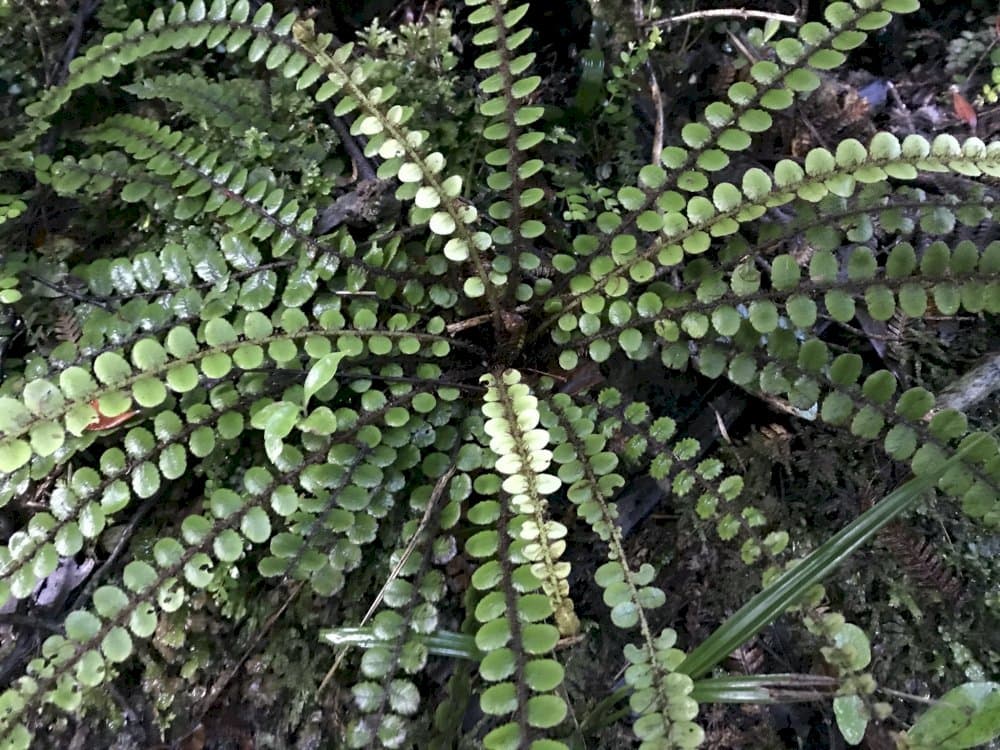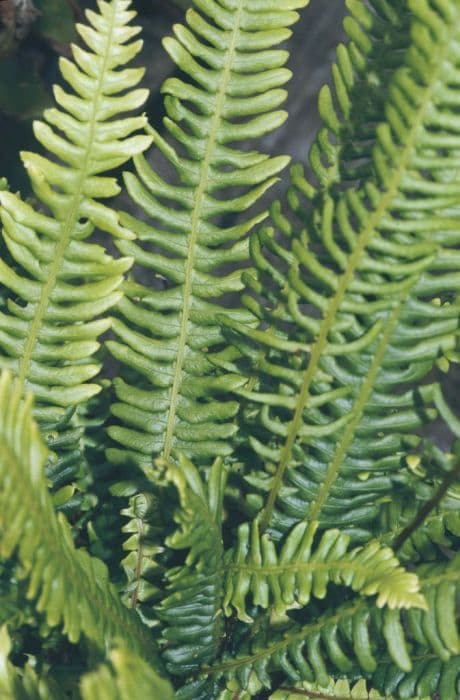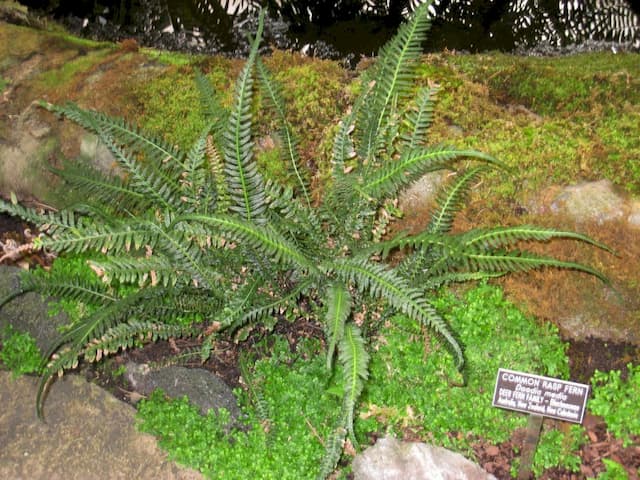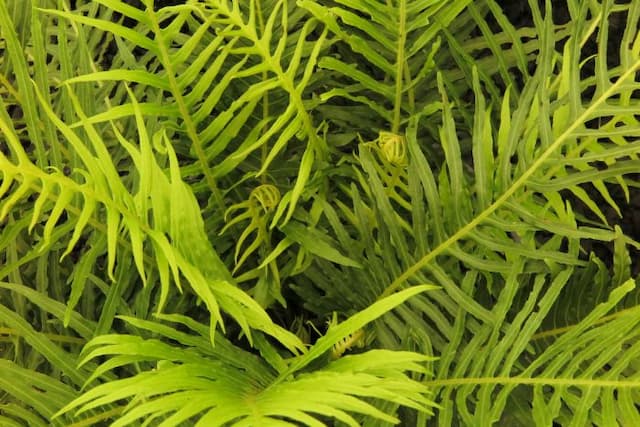Kiokio Blechnum fluviatile

ABOUT
The plant known as the water fern features a distinctive and lush appearance, with its most notable characteristic being the elegant and long fronds that gracefully cascade. These fronds display a rich, deep green color and have a textured look, with an overlapping pattern that resembles the tiles on a roof. The texture is often described as leathery to the touch, indicating a sturdy and resilient nature. As a water fern, it thrives in moist conditions, which contributes to its glossy and vibrant look. The overall impression of the water fern is one of a compact and densely foliated plant, which provides a lush, green aesthetic ideal for adding a touch of tranquility and natural beauty to any suitable environment. Its fronds emerge from a central base, giving it a symmetrical appearance that is both tidy and organized.
About this plant
 Names
NamesFamily
Blechnaceae
Synonyms
Water Fern, Stream Fern, Kiwikiwi, River Fern
Common names
Blechnum ambiguum, Lomaria fluviatilis, Lomaria lanceolata, Blechnum lanceolatum, Struthiopteris fluviatilis.
 Toxicity
ToxicityTo humans
The plant known as the water fern (Blechnum fluviatile) is not widely recognized for being toxic to humans. However, as with many plants, it is generally advised to avoid ingesting parts of plants that are not known to be edible, as they can cause unwanted reactions. There is limited information about the toxicity of water fern if ingested by humans, and there may be individual variations in sensitivity. Hence, while there are no well-documented cases of poisoning, precaution should be taken around it, especially with children who might be more prone to ingesting plant material.
To pets
Water fern (Blechnum fluviatile) is not commonly listed as toxic to pets. However, pets have different metabolisms and sensitivities compared to humans, and it’s possible that some pets may experience mild gastrointestinal upset if they ingest the plant. Signs of possible plant poisoning in pets can include vomiting, diarrhea, drooling, or changes in appetite. To ensure the safety of your pets, it's best to prevent them from having access to or ingesting this or any unknown plants. If you suspect your pet has ingested the water fern and is showing symptoms of illness, seek veterinary attention.
 Characteristics
CharacteristicsLife cycle
Perennials
Foliage type
Evergreen
Color of leaves
Green
Height
1-2 feet (30-60 cm)
Spread
1-2 feet (30-60 cm)
Plant type
Fern
Hardiness zones
9
Native area
Australasia
Benefits
 General Benefits
General Benefits- Ornamental value: Blechnum fluviatile, commonly known as Water Fern, is an attractive fern with a neat rosette of arching fronds that can add a lush, green aesthetic to gardens and landscapes.
- Shade tolerance: Water Fern can thrive in shady areas where many other plants struggle, making it valuable for filling in dark or underutilized spaces in the garden.
- Low maintenance: Once established, Water Fern is relatively easy to care for, requiring minimal attention, which makes it a good choice for both novice and experienced gardeners.
- Soil erosion control: The dense root system of Water Fern can help stabilize soil, preventing erosion, particularly in moist or riverside environments.
- Habitat for wildlife: Water Fern provides habitat and food for certain insects and animals, contributing to the ecological diversity of an area.
- Ground cover: It can serve as an effective ground cover, suppressing weeds and reducing garden maintenance further.
 Medical Properties
Medical PropertiesThis plant is not used for medical purposes.
 Air-purifying Qualities
Air-purifying QualitiesThis plant is not specifically known for air purifying qualities.
 Other Uses
Other Uses- The fronds of the water fern can be used as a natural mulch in gardens, helping to maintain soil moisture and suppress weeds.
- In some cultures, the sturdy fronds may be woven into mats or baskets, utilizing their durability and flexibility.
- Water fern can be used in constructed wetlands for wastewater treatment, taking advantage of its tolerance to wet conditions.
- This plant can be placed in aquariums or water gardens as a decorative element that also provides a habitat for aquatic life.
- Fine root hairs of the water fern can be utilized in crafting as a natural binding material.
- The plant can be used in educational settings to teach about botany and the life cycle of ferns.
- Water fern can be incorporated into landscaping projects to stabilize stream banks and control soil erosion.
- As a subject for botanical illustration and photography, the intricate fronds and structure offer aesthetic appeal.
- In some artisanal paper-making processes, fibers from the fronds may be used to create a textured paper.
- During thematic events or celebrations, its distinctive fronds can be used as natural decor to create a woodland or riverine ambiance.
Interesting Facts
 Feng Shui
Feng ShuiThe Water fern is not used in Feng Shui practice.
 Zodiac Sign Compitability
Zodiac Sign CompitabilityThe Water fern is not used in astrology practice.
 Plant Symbolism
Plant Symbolism- Resilience: As a fern that thrives in waterways and damp environments, the Blechnum fluviatile, commonly known as the Water fern, symbolizes adaptability and the ability to endure challenging conditions.
- Growth: Ferns in general are often associated with growth and new beginnings due to their proliferation in nature, thus Water fern might represent an unfolding of fresh ideas or perspectives.
- Shelter: The Water fern can provide habitats and shelter for various species, symbolizing protection and nurturing.
- Eternal youth: Ferns are ancient plants that have survived through the ages. As such, Water fern could represent the concept of eternal youth and persistence through time.
- Secretive: In some cultures, ferns are associated with mystery and privacy due to their dense habitats. Water fern could therefore symbolize hidden beauty or the unseen.
 Water
WaterThe Water Fern should be kept in consistently moist soil without becoming waterlogged. It is best to water the plant lightly on a frequent basis, roughly every few days, depending on the humidity and temperature conditions. The amount of water needed will vary, but the goal is to maintain even moisture; typically, this might involve adding approximately 16 ounces of water per week, adjusting as necessary to ensure the soil remains moist to the touch.
 Light
LightThe Water Fern thrives best in partial shade with indirect sunlight. It is well-suited for spots that receive dappled light or are shaded by taller plants. Direct, harsh sunlight should be avoided to prevent scorching the leaves.
 Temperature
TemperatureThe Water Fern prefers a temperature range between 60 and 75 degrees Fahrenheit, but can survive in temperatures as low as 50 degrees and as high as 80 degrees. Keeping the plant in its ideal temperature range will promote healthy growth and development.
 Pruning
PruningPruning the Water Fern is mainly to remove any dead or damaged fronds to keep the plant healthy and encourage new growth. It is ideal to prune in the spring or early summer, as this is when the plant is most actively growing. Pruning should be done sparingly, as the plant generally maintains a neat form on its own.
 Cleaning
CleaningAs needed
 Soil
SoilThe Water fern prefers a well-draining soil mix rich in organic matter with a pH range of 5.5-6.5. A combination of 50% peat moss or coco coir with 30% perlite and 20% compost works well for this plant's growth.
 Repotting
RepottingWater ferns should typically be repotted every two to three years or when the plant outgrows its current pot, to ensure continued growth and prevent root crowding.
 Humidity & Misting
Humidity & MistingWater fern thrives in high humidity, with ideal levels being between 60-80%. Mist regularly to maintain these conditions, especially in dry indoor environments.
 Suitable locations
Suitable locationsIndoor
Keep the Water fern in bright, indirect light and maintain high humidity.
Outdoor
Place Water fern in partial shade; keep soil moist and protect from strong winds.
Hardiness zone
9-11 USDA
 Life cycle
Life cycleThe life cycle of Blechnum fluviatile, commonly known as the Water fern, begins with spore germination. After dispersal, the spores grow into a small, heart-shaped gametophyte called a prothallus, which is the sexual stage of the plant. The prothallus produces both male and female reproductive organs, and once fertilization occurs, it gives rise to a small sporophyte, which will grow into the mature fern. The Water fern then develops a rhizome from which fronds emerge and unfurl into the familiar leafy structure. These fronds are dimorphic, with some adapted for photosynthesis and others for reproduction, bearing sporangia underneath. The cycle comes full circle when the mature sporangia release spores into the environment, beginning a new generation of Water ferns.
 Propogation
PropogationPropogation time
Spring-summer
The most popular method of propagation for Blechnum fluviatile, commonly known as the Water Fern, is through spores. These spores are typically collected when they mature on the undersides of the fronds, generally in the summer. The process involves sowing spores on the surface of a moist, sterilized soil mix, often consisting of peat and sand in equal parts, within a temperature-controlled environment that provides consistent warmth, ideally around 68-72 degrees Fahrenheit (20-22 degrees Celsius). Covering the container with a plastic lid or wrap helps maintain the required high humidity. Spore propagation requires patience, as it can take several weeks to months for the spores to germinate and even longer for the Water Fern to grow large enough to be planted out.




